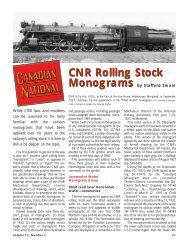CN LINES V12N3 - Canadian National Railways Historical Association
CN LINES V12N3 - Canadian National Railways Historical Association
CN LINES V12N3 - Canadian National Railways Historical Association
Create successful ePaper yourself
Turn your PDF publications into a flip-book with our unique Google optimized e-Paper software.
elow: By the early 1960s the Bodo Subdivision had become grain dependent. As with other prairie branches the <strong>Canadian</strong> Wheat<br />
Board implemented the grain block system in the 1969 crop year. At the time the Bodo Subdivision was on the Alberta District.<br />
Locomotives and crews for train operating on the line were based in Calder Yard-Edmonton. By the mid-1980s the line was operated<br />
an average of once every two weeks. Due to deferred maintenance, the line was restricted to lightweight GMD1 units in the 1000series,<br />
rebuilt in 1988-89 into the 1600-series. Typically, the three units used in this wayfreight service were moved in an eastbound<br />
train from Calder to Biggar. Over the next couple of days these units would make Turns from Biggar peddling empties and grain loads<br />
up and down the Porter and the Dodsland Subdivisions. The following day these same units would pick up grain empties at Biggar,<br />
spot them at the elevators on the way down the Bodo Subdivision and lift the loads on the return leg. Once back at Biggar, the units<br />
and grain loads would be cut into a westbound train and return to Calder Yard. In January 1990 jurisdiction over the Bodo Subdivision<br />
was transferred to the Prairie Region Saskatchewan District. In the final years of operation on the Bodo Subdivision, two units were<br />
usually sufficient to handle the local traffic. Here GMD1u’s 1612 and 1614 leave the elevator track at Reward after spotting 13 empties<br />
at the 1930s-vintage elevators on 19 September 1989.—L. S. Kozma photo<br />
left: The trailing shot looking southwesterly shows the Extra Mixed stretched out across<br />
the trestle and the coulee in August 1957. The 23 cars in this train were likely all this<br />
single SW1200RS could handle, even with the moderate grades (westbound maximum<br />
0.4%, compensated) on the Bodo Subdivision. Two tank cars (likely lubricating oil and/or<br />
gasoline bound for the bulk oil plants at Reward—Imperial Oil and B-A—and at Cactus<br />
Lake—Imperial Oil—but their location in the train suggests both were for Reward) were<br />
marshalled right behind the locomotive (now a “no-no,” for safety reasons). Following the<br />
tank cars were an empty flat car, two stock cars, a mixed bag of seven single-sheathed<br />
wood and eight steel boxcars, a wooden express reefer, an ancient mail-express car<br />
(possibly of <strong>CN</strong>oR heritage) and, finally, the caboose. The loaded boxcars likely carried<br />
merchandise and domestic coal. The empty boxcars were likely for grain loading at some<br />
of the 13 country elevators or the numerous grain loading platforms along the branch.<br />
Clearly, stock was also to be loaded. The reefer and the mail-express car were for lessthan-carload<br />
lot (l.c.l.) freight for distribution to the local stations along the line.<br />
Passengers desperate enough to catch this train presumably rode in the caboose. This<br />
unscheduled Mixed likely met its demise by 1960. Freight service continued on an asrequired<br />
basis.—Bill Johnston photo<br />
Volume 12, Number 3 7



